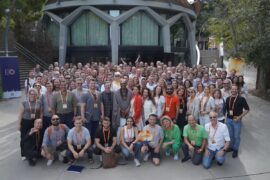
Since the Walkman we have walked from one place to...

Who is primarily responsible for the so-called "greenhouse effect"? What...

The festival redoubles its commitment to offering a wide variety...

According to the United Nations, attracting the financial system is...

Experiencing a match day in the Wanda Metropolitano Stadium allows...

The Catalan seed company invoices 64% of turnover through exports,...

Entrepreneurs' Organization promotes entrepreneurship in community and from a holistic...

A tree in the city is much more than ornamentation...

A good friend is with you to the end of...

The importance of the logistics and transport industry is unquestionable....

Música clásica sobre la arena de la playa en dos...

The first session of the cycle on the regatta organized...

The hospital's managing director, Manel del Castillo, and the pharmaceutical...

Generalitat y Ayuntamiento impulsarán dos equipamientos de 'Casa de les...

Leticia Beleta, director of Alexion Pharmaceuticals in Spain and Portugal,...

We all have a friend who never leaves the Gràcia...

Barcelona director opts for Best International Film with 'La sociedad...

The hotel and industrial sectors softened the market's decline last...

The technology company, with a workforce of 35 employees and...

“The women of yesteryear were strong and had to fight...

“The greatest teacher, failure is” (Master Yoda). Yoda’s quote, built up as a hyperbaton construction, may not seem applicable to the film in which it appears. The premiere of The Last Jedi (2017), on 15th December, has been the second-best opening ever in the US, behind its previous release (probably because of its sudden long-awaited release of the original trilogy). The Force Awakens (2015) made $210 M, and recovered on its first days at theatres its overall production costs, and the new episode follows suit. Star Wars is a success story, at least financially, and a story of non-stop triumphs.
AN EPIC RECEPTION
Its recent overwhelming success story is not new. The work that gave name to the whole saga, Star Wars, became in 1977 an unexpected cinema and social blockbuster with huge economic returns for its creators: an investment of $11 M gave way to benefits of over $460 M. Nor could producers forecast the influence and repercussion of the Start Wars phenomenon, since they granted the merchandising exploitation rights to young filmmaker, Georges Lucas.
The characters, performed by novel actors, were received as archetypes, icons of timeless validity, while androids and space vessels became cult items. All of them became icons of a reality that constitutes the collective imagery to the present time, rediscovered in all types of consumer items (from entertainment, of course, but also in the fashion or food industry). All products deriving from this faraway sci-fi world fulfil a ritual function, and endow their owners with a myth-type narrative.
All products deriving from this faraway sci-fi world fulfil a ritual function, and endow their owners with a myth-type narrative
It is tempting to believe that the success of the Star Wars saga comes from a deployment of an aggressive marketing strategy. But this interpretation may well be read backwards: this massive deployment is triggered after the interest created by the complexity of the issues discussed in this fiction, well beyond traditional action movies, where the “good” and the “villains” fight against each other with no truce or ambiguities.
The plethora of creatures never witnessed or imagined before, as well as its special effects, capture the spectator’s attention, while the clever use of the soundtrack, composed by John Williams adds a deeper and more believable dimension to the plot, by using it as a leitmotiv; that is, allocating recurrent tunes to characterize specific characters, thus amplifying the impact of the situations they come across. Overall, the audio-visual grandiloquence works as long as it is a proposal that transcends and is narrated with an epic tone, as the epic of foundational values, located beyond the immediate context of the spectator (“a long time ago, in a faraway galaxy”).
SPIRITUALITY PERPETUATED IN TRILOGIES
““Humanity begins the moment we stop being instinctively selfish and start seeing other points of view”, said Akira Kurosawa, pleasantly surprised with the capacity of sacrifice of the human being. The acknowledgement and affection of Georges Lucas for the Japanese filmmaker is obvious, and in fact he acknowledged his debt towards such films as Rashomon, The seven samurais or, especially, Hidden Fortress.
This influence accounts for the Jedi aesthetics and discipline. The Katanas become laser beams and kimonos are the outfits worn by Buddhists, a life philosophy that rejects satisfaction of one’s own interests.
The absence of theoretical tenets in Buddhism is counteracted by a practical bias based on empathy that is no less demanding than theory. Nevertheless, the proposal of alternative spirituality offered by Star Wars is profoundly successful on commercial terms. It is a well-known fact that fiction -series and films of our times- performs in the popular imaginary the function of a mirror where we need to look at ourselves in order to accept ourselves and the others, and one where axiological issues, related to values, are discussed (this role is compared to that of the novel and the analysis carried out by Paul Ricoeur in Temps et récit o a Soi-même comme un autre).
The saga of the Jedi warriors functions in the cosmovision of different generations of spectators as a foundational myth, as a religious narrative that sucks you in from its inception, with the original trilogy, through the scission and identification of the father and the child, which becomes a Christ-like figure because of the crisis experience when finding out the truth and suffering as a result of it. The Freudian interpretation signals the ambivalence of this family relationship of love-hate, present in all myths in the origins of many civilizations, including the Christian civilization (and whose psychoanalytical interpretation, well into the 20th century, is the confession of that dream of one of Freud’s patients: “Father, can’t you see I’m on fire?”).
The saga of the Jedi warriors functions in the cosmovision of different generations of spectators as a foundational myth
The child redeems the father who has driven him to misunderstanding of exaggerated suffering, then saves him, and promotes his gaze turn in Return of the Jedi thus perpetuating the emotional intensity of The Empire Strikes Back, one of the best second parts in the history of cinema. The second trilogy, on the other hand, is a true anti-climax, set right by the third trilogy of the last few years.
In the figure of Kylo Ren -son of Han Solo and Leia- but also Luke as an old man, who Yoda insists on calling “young Skywalker” in The last Jedi, we rediscover the correspondence between good and evil, as a two-sided -non-excluding- coin. The “dark side of force” arises in Kylo Ren, just like with his grandfather Darth Vader, and also feelings of doubt and hesitation. The parallelisms are far from accidental, quite the opposite. Luke is tempted to extinguish it, to deny it for fear, but this does but driving on his reality.
THE FORCE, COSMIC PRINCIPLE
What is truly engaging about the Star Wars saga from its initial trilogy is the psychology of its characters and the weaving of love and family ties revealed gradually, and its ties with a principle of mystic connotations, like “the force”. The term (force) may describe its physical sense, of power, as those who find it in themselves with more intensity -the Jedi- are also skilled for fight, and levitate loads with the power of their mind. Here lies the other meaning of the term; that representing the force as the spiritual principle, despite its elusiveness or incomprehensibility as an entirely rational term.
The definition of the Force is solemnly announced in the first film of the saga -chronologically speaking- by one of the most charismatic Jedi, Obi-Wan Kenobi to Luke: “the Force is an energy field created by all living things. It surrounds us, penetrates us, and binds the galaxy together”.
Virtually identical -one might think at first sight-, as the definition from Rey to Luke Skywalker in The Last Jedi, on being asked about what the Force was: “It’s a power that Jedi have that lets them control people and make things float”. Luke’s answer cannot be more categorical: “Impressive… Every word in that sentence is wrong”. Not because the Jedi are not powerful, in the strict sense of the word, but because this statement is based on belief, on myths, and is unaware that, as Luke points out, the Force is not a power that the Jedi own exclusively; even when the Force grants them this power, once they feel it inside them, it is recognized as “balance and energy” -will wisely rectify Rey. But this understanding is not intellectual, cannot be taken for granted, as it will degrade anyone who thinks himself powerful.
The demystification process of the typically Jedi concepts, in the last release of the saga, represents an essential part of discipline
The destruction of the temple or the burning of the Sacred books point out to the need to transcend the legend and protect the disciple against reckless deification. The demystification process of the typically Jedi concepts, in the last release of the saga, represents an essential part of discipline, seeking restoration. This means one step beyond by criticising a dichotomized Manichean view, which assumes the good as an inherent part of the Force, while the evil is its dark side. (To be continued…)

“The greatest teacher, failure is” (Master Yoda). Yoda’s quote, built up as a hyperbaton construction, may not seem applicable to the film in which it appears. The premiere of The Last Jedi (2017), on 15th December, has been the second-best opening ever in the US, behind its previous release (probably because of its sudden long-awaited release of the original trilogy). The Force Awakens (2015) made $210 M, and recovered on its first days at theatres its overall production costs, and the new episode follows suit. Star Wars is a success story, at least financially, and a story of non-stop triumphs.
AN EPIC RECEPTION
Its recent overwhelming success story is not new. The work that gave name to the whole saga, Star Wars, became in 1977 an unexpected cinema and social blockbuster with huge economic returns for its creators: an investment of $11 M gave way to benefits of over $460 M. Nor could producers forecast the influence and repercussion of the Start Wars phenomenon, since they granted the merchandising exploitation rights to young filmmaker, Georges Lucas.
The characters, performed by novel actors, were received as archetypes, icons of timeless validity, while androids and space vessels became cult items. All of them became icons of a reality that constitutes the collective imagery to the present time, rediscovered in all types of consumer items (from entertainment, of course, but also in the fashion or food industry). All products deriving from this faraway sci-fi world fulfil a ritual function, and endow their owners with a myth-type narrative.
All products deriving from this faraway sci-fi world fulfil a ritual function, and endow their owners with a myth-type narrative
It is tempting to believe that the success of the Star Wars saga comes from a deployment of an aggressive marketing strategy. But this interpretation may well be read backwards: this massive deployment is triggered after the interest created by the complexity of the issues discussed in this fiction, well beyond traditional action movies, where the “good” and the “villains” fight against each other with no truce or ambiguities.
The plethora of creatures never witnessed or imagined before, as well as its special effects, capture the spectator’s attention, while the clever use of the soundtrack, composed by John Williams adds a deeper and more believable dimension to the plot, by using it as a leitmotiv; that is, allocating recurrent tunes to characterize specific characters, thus amplifying the impact of the situations they come across. Overall, the audio-visual grandiloquence works as long as it is a proposal that transcends and is narrated with an epic tone, as the epic of foundational values, located beyond the immediate context of the spectator (“a long time ago, in a faraway galaxy”).
SPIRITUALITY PERPETUATED IN TRILOGIES
““Humanity begins the moment we stop being instinctively selfish and start seeing other points of view”, said Akira Kurosawa, pleasantly surprised with the capacity of sacrifice of the human being. The acknowledgement and affection of Georges Lucas for the Japanese filmmaker is obvious, and in fact he acknowledged his debt towards such films as Rashomon, The seven samurais or, especially, Hidden Fortress.
This influence accounts for the Jedi aesthetics and discipline. The Katanas become laser beams and kimonos are the outfits worn by Buddhists, a life philosophy that rejects satisfaction of one’s own interests.
The absence of theoretical tenets in Buddhism is counteracted by a practical bias based on empathy that is no less demanding than theory. Nevertheless, the proposal of alternative spirituality offered by Star Wars is profoundly successful on commercial terms. It is a well-known fact that fiction -series and films of our times- performs in the popular imaginary the function of a mirror where we need to look at ourselves in order to accept ourselves and the others, and one where axiological issues, related to values, are discussed (this role is compared to that of the novel and the analysis carried out by Paul Ricoeur in Temps et récit o a Soi-même comme un autre).
The saga of the Jedi warriors functions in the cosmovision of different generations of spectators as a foundational myth, as a religious narrative that sucks you in from its inception, with the original trilogy, through the scission and identification of the father and the child, which becomes a Christ-like figure because of the crisis experience when finding out the truth and suffering as a result of it. The Freudian interpretation signals the ambivalence of this family relationship of love-hate, present in all myths in the origins of many civilizations, including the Christian civilization (and whose psychoanalytical interpretation, well into the 20th century, is the confession of that dream of one of Freud’s patients: “Father, can’t you see I’m on fire?”).
The saga of the Jedi warriors functions in the cosmovision of different generations of spectators as a foundational myth
The child redeems the father who has driven him to misunderstanding of exaggerated suffering, then saves him, and promotes his gaze turn in Return of the Jedi thus perpetuating the emotional intensity of The Empire Strikes Back, one of the best second parts in the history of cinema. The second trilogy, on the other hand, is a true anti-climax, set right by the third trilogy of the last few years.
In the figure of Kylo Ren -son of Han Solo and Leia- but also Luke as an old man, who Yoda insists on calling “young Skywalker” in The last Jedi, we rediscover the correspondence between good and evil, as a two-sided -non-excluding- coin. The “dark side of force” arises in Kylo Ren, just like with his grandfather Darth Vader, and also feelings of doubt and hesitation. The parallelisms are far from accidental, quite the opposite. Luke is tempted to extinguish it, to deny it for fear, but this does but driving on his reality.
THE FORCE, COSMIC PRINCIPLE
What is truly engaging about the Star Wars saga from its initial trilogy is the psychology of its characters and the weaving of love and family ties revealed gradually, and its ties with a principle of mystic connotations, like “the force”. The term (force) may describe its physical sense, of power, as those who find it in themselves with more intensity -the Jedi- are also skilled for fight, and levitate loads with the power of their mind. Here lies the other meaning of the term; that representing the force as the spiritual principle, despite its elusiveness or incomprehensibility as an entirely rational term.
The definition of the Force is solemnly announced in the first film of the saga -chronologically speaking- by one of the most charismatic Jedi, Obi-Wan Kenobi to Luke: “the Force is an energy field created by all living things. It surrounds us, penetrates us, and binds the galaxy together”.
Virtually identical -one might think at first sight-, as the definition from Rey to Luke Skywalker in The Last Jedi, on being asked about what the Force was: “It’s a power that Jedi have that lets them control people and make things float”. Luke’s answer cannot be more categorical: “Impressive… Every word in that sentence is wrong”. Not because the Jedi are not powerful, in the strict sense of the word, but because this statement is based on belief, on myths, and is unaware that, as Luke points out, the Force is not a power that the Jedi own exclusively; even when the Force grants them this power, once they feel it inside them, it is recognized as “balance and energy” -will wisely rectify Rey. But this understanding is not intellectual, cannot be taken for granted, as it will degrade anyone who thinks himself powerful.
The demystification process of the typically Jedi concepts, in the last release of the saga, represents an essential part of discipline
The destruction of the temple or the burning of the Sacred books point out to the need to transcend the legend and protect the disciple against reckless deification. The demystification process of the typically Jedi concepts, in the last release of the saga, represents an essential part of discipline, seeking restoration. This means one step beyond by criticising a dichotomized Manichean view, which assumes the good as an inherent part of the Force, while the evil is its dark side. (To be continued…)
